

Compact Muon Solenoid
LHC, CERN
| CMS-PAS-B2G-18-007 | ||
| Search for new physics in events with collimated photons and gluons | ||
| CMS Collaboration | ||
| March 2019 | ||
| Abstract: This letter reports the results of a search for physics beyond the standard model. The search is performed with events containing jets with substructure resulting from new particles decaying into a photon and two gluons. Jet substructure techniques are adapted to develop a new approach for photon identification in a dense hadronic environment. The proton-proton collision data analyzed were collected by the CMS experiment at √s= 13 TeV during 2016 and correspond to an integrated luminosity of 35.9 fb−1. No statistically significant excess is observed and the first cross section limits on processes yielding such events are set. | ||
|
Links:
CDS record (PDF) ;
CADI line (restricted) ;
These preliminary results are superseded in this paper, PRL 123 (2019) 241801. The superseded preliminary plots can be found here. |
||
| Figures | |
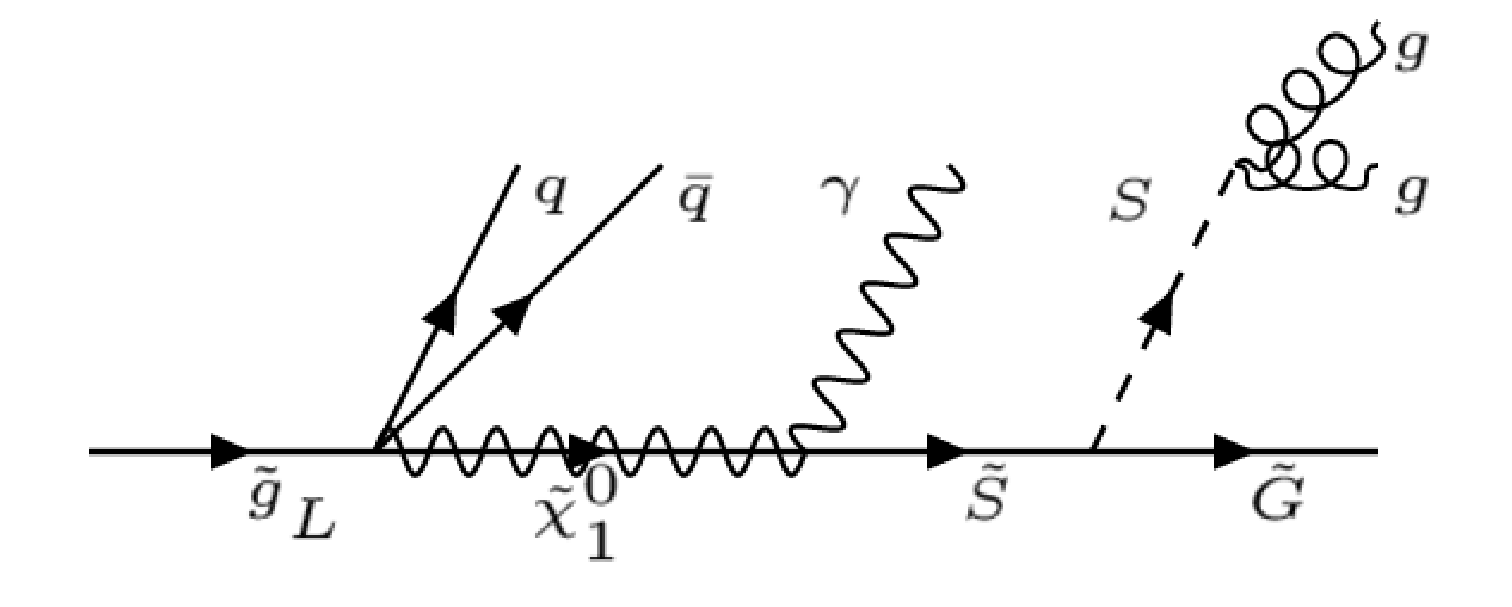
png pdf |
Figure 1:
The decay diagram for a gluino predicted by stealth SUSY. The S and ˜S states are predicted to have a small mass gap resulting in soft ˜G emissions. This analysis mainly explores cases where the mass difference between the ˜g and ˜χ01 is large and results in a high momentum ˜χ01 with the photon and the gluons merging into a single jet. |
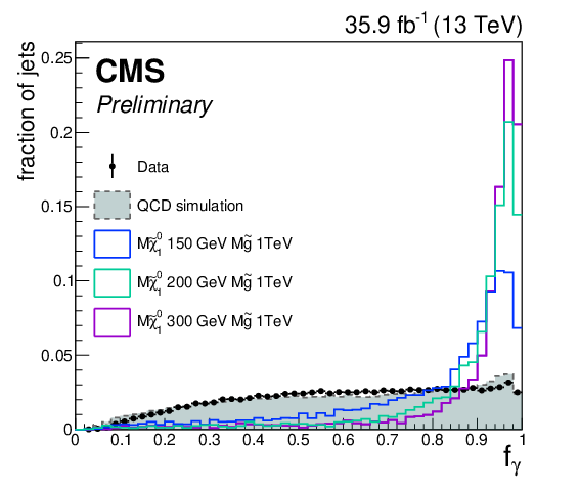
png pdf |
Figure 2:
Normalized distribution of the fγ variable. Simulated signal jets are denoted with the colored lines, each depicting a different mass of ˜χ01 and ˜g. The shaded area represents the QCD jets distribution. The black points present data. The jet distributions presented here are required to satisfy the loose photon-jet requirements. |
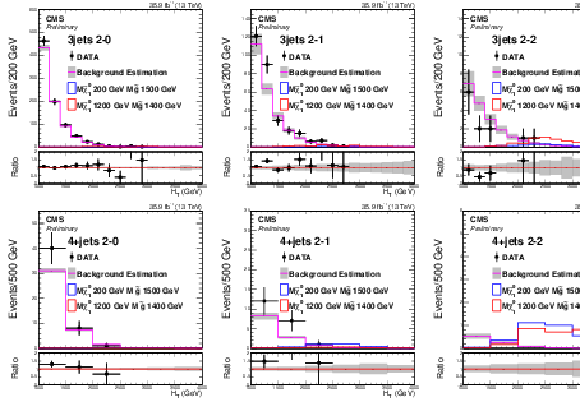
png pdf |
Figure 3:
Signal region HT distributions for the AK8 3 jet category (top row) and the 4+ AK8 category (bottom). Events with zero, one and two tight photon-jets are presented from left to right, present events with different number of tight photon-jets. The balck points denote the observed data HT distributions. The magenta line with the gray band, presents the data based background estimation prediction while the other colored lines present expected single HT distributions. |

png pdf |
Figure 3-a:
Signal region HT distributions for the AK8 3 jet category. Events with zero, one and two tight photon-jets are presented from left to right, present events with different number of tight photon-jets. The balck points denote the observed data HT distributions. The magenta line with the gray band, presents the data based background estimation prediction while the other colored lines present expected single HT distributions. |

png pdf |
Figure 3-b:
Signal region HT distributions for the 4+ AK8 category. Events with zero, one and two tight photon-jets are presented from left to right, present events with different number of tight photon-jets. The balck points denote the observed data HT distributions. The magenta line with the gray band, presents the data based background estimation prediction while the other colored lines present expected single HT distributions. |
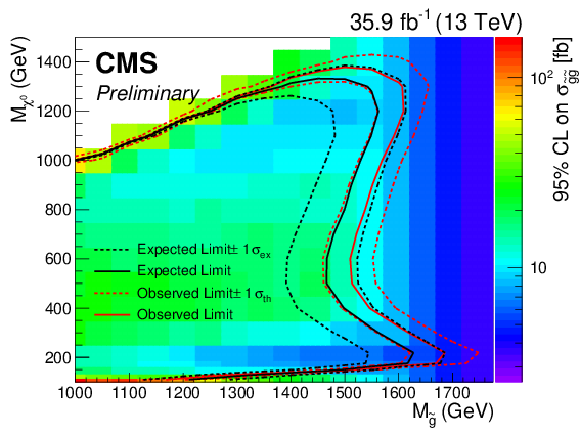
png pdf |
Figure 4:
The excluded mass parameter space for the gluino and neutralino masses. The region left of the red exclusion line is excluded. The black line defines the expected excluded area based on the data driven background estimation. The error on the observed limit corresponds to the cross section theoretical uncertainties. The color scale denoted the the upper limits on the cross section for pair production of ˜g, for each mass point at the 95% confidence level. Exclusion in the low ˜χ01 high ˜g mass region is a result of the implementation of substructure techniques. |
| Tables | |
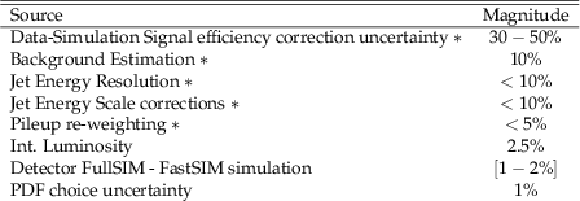
png pdf |
Table 1:
Systematic uncertainties considered. The starred ∗ uncertainties are evaluated as shape uncertainties while the rest as uncertainties on the normalization. The magnitude of each uncertainty refers to the effect on signal event efficiencies. |
| Summary |
| To summarize, a search for superparticle production is presented, performed in events with two substructure rich jets composed of a photon and two gluons, using a pp collisions dataset collected by the CMS experiment and corresponding to an integrated luminosity of 35.9 fb−1. This is the first search of its kind targeting the region of parameter space where photons from neutralino decays are not isolated. We use existing jet-substructure variables and novel techniques to identify the unusual jets. The total hadronic activity distributions of events are compared to distributions directly estimated from data. No statistically significant excess is observed above the SM expectation. We establish upper limits with 95% confidence level on gluino pair production cross section using a simplified stealth SUSY model. The excluded gluino masses extend up to 1.5-1.7 TeV depending on the neutralino mass with the highest exclusion set for neutralinos with a mass of about 200 GeV. |
| References | ||||
| 1 | M. J. Strassler and K. M. Zurek | Echoes of a hidden valley at hadron colliders | PLB651 (2007) 374 | hep-ph/0604261 |
| 2 | M. J. Strassler | Possible effects of a hidden valley on supersymmetric phenomenology | hep-ph/0607160 | |
| 3 | CMS Collaboration | Searches for r-parity-violating supersymmetry in pp collisions at √s= 8 TeV in final states with 0--4 leptons | PRD 94 (2016) 112009 | CMS-SUS-14-003 1606.08076 |
| 4 | J. Fan, M. Reece, and J. T. Ruderman | A stealth supersymmetry sampler | Journal of High Energy Physics 2012 (Jul, 2012) 196 | 1201.4875 |
| 5 | J. Fan, M. Reece, and J. T. Ruderman | Stealth supersymmetry | JHEP 11 (2011) 012 | 1105.5135 |
| 6 | J. Fan et al. | Stealth supersymmetry simplified | JHEP 07 (2016) 016 | 1512.05781 |
| 7 | CMS Collaboration | Search for stealth supersymmetry in events with jets, either photons or leptons, and low missing transverse momentum in pp collisions at 8 TeV | PLB743 (2015) 503 | CMS-SUS-14-009 1411.7255 |
| 8 | CMS Collaboration | Search for supersymmetry in events with photons and low missing transverse energy in pp collisions at √s= 7 TeV | PLB719 (2013) 42 | CMS-SUS-12-014 1210.2052 |
| 9 | CMS Collaboration | The CMS experiment at the CERN LHC | JINST 3 (2008) S08004 | CMS-00-001 1206.4071 |
| 10 | CMS Collaboration | Particle-flow reconstruction and global event description with the CMS detector | JINST 12 (2017) P10003 | CMS-PRF-14-001 1706.04965 |
| 11 | M. Cacciari, G. P. Salam, and G. Soyez | The anti-kt jet clustering algorithm | JHEP 04 (2008) 063 | 0802.1189 |
| 12 | M. Cacciari, G. P. Salam, and G. Soyez | FastJet user manual | EPJC 72 (2012) 1896 | 1111.6097 |
| 13 | CMS Collaboration | Jet algorithms performance in 13 TeV data | CMS-PAS-JME-16-003 | CMS-PAS-JME-16-003 |
| 14 | CMS Collaboration | Jet energy calibrations at CMS experiment with 13 TeV collisions | PoS EPS-HEP2017 (2017) 805 | |
| 15 | CMS Collaboration | The CMS trigger system | Journal of Instrumentation 12 (2017), no. 01, P01020 | CMS-TRG-12-001 1609.02366 |
| 16 | J. Alwall et al. | The automated computation of tree-level and next-to-leading order differential cross sections, and their matching to parton shower simulations | JHEP 07 (2014) 079 | 1405.0301 |
| 17 | T. Sjöstrand et al. | An introduction to PYTHIA 8.2 | CPC 191 (2015) 159 | 1410.3012 |
| 18 | CMS Collaboration | Event generator tunes obtained from underlying event and multiparton scattering measurements | EPJC76 (2016), no. 3, 155 | CMS-GEN-14-001 1512.00815 |
| 19 | NNPDF Collaboration | Parton distributions with LHC data | NPB 867 (2013) 244 | 1207.1303 |
| 20 | S. Abdullin et al. | The fast simulation of the CMS detector at LHC | J. Phys. Conf. Ser. 331 (2011) 032049 | |
| 21 | A. Giammanco | The Fast Simulation of the CMS Experiment | J. Phys. Conf. Ser. 513 (2014) 022012 | |
| 22 | GEANT4 Collaboration | GEANT4: A Simulation toolkit | NIMA506 (2003) 250--303 | |
| 23 | M. Bahr et al. | Herwig++ physics and manual | EPJC58 (2008) 639--707 | 0803.0883 |
| 24 | S. Gieseke, C. Rohr, and A. Siodmok | Colour reconnections in Herwig++ | EPJC72 (2012) 2225 | 1206.0041 |
| 25 | C. Borschensky et al. | Squark and gluino production cross sections in pp collisions at √s= 13, 14, 33 and 100 TeV | EPJC74 (2014), no. 12 | 1407.5066 |
| 26 | J. Alwall et al. | Comparative study of various algorithms for the merging of parton showers and matrix elements in hadronic collisions | EPJC53 (2008) 473--500 | 0706.2569 |
| 27 | P. Nason | A New method for combining NLO QCD with shower Monte Carlo algorithms | JHEP 11 (2004) 040 | hep-ph/0409146 |
| 28 | S. Frixione, P. Nason, and C. Oleari | Matching NLO QCD computations with parton shower simulations: the POWHEG method | JHEP 11 (2007) 070 | 0709.2092 |
| 29 | S. Alioli, P. Nason, C. Oleari, and E. Re | A general framework for implementing NLO calculations in shower Monte Carlo programs: the POWHEG BOX | JHEP 06 (2010) 043 | 1002.2581 |
| 30 | S. Frixione, P. Nason, and G. Ridolfi | A Positive-weight next-to-leading-order Monte Carlo for heavy flavour hadroproduction | JHEP 09 (2007) 126 | 0707.3088 |
| 31 | S. Catani, Y. L. Dokshitzer, M. H. Seymour, and B. R. Webber | Longitudinally invariant kT clustering algorithms for hadron hadron collisions | NPB406 (1993) 187 | |
| 32 | J. Thaler and K. Van Tilburg | Identifying boosted objects with N-subjettiness | JHEP 3 (2011) 15 | 1011.2268 |
| 33 | CMS Collaboration | Identification of heavy-flavour jets with the CMS detector in pp collisions at 13 TeV | Submitted to JINST | CMS-BTV-16-002 1712.07158 |
| 34 | G. Cowan | Statistics, in Review of particle physics | CPC 40 (2016) 100001 | |

|
Compact Muon Solenoid LHC, CERN |

|

|

|

|

|

|